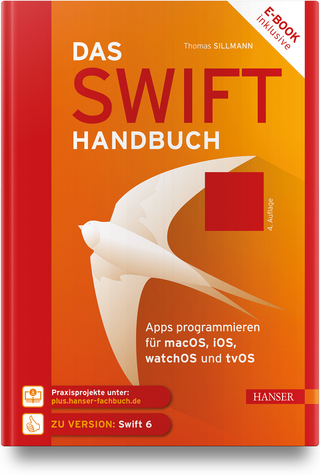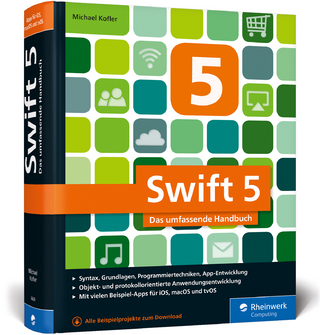
Professional Swift
Wrox Press (Verlag)
978-1-119-01677-9 (ISBN)
- Titel ist leider vergriffen;
keine Neuauflage - Artikel merken
Transition from Objective-C to the cleaner, more functional Swift quickly and easily Professional Swift shows you how to create Mac and iPhone applications using Apple's new programming language. This code-intensive, practical guide walks you through Swift best practices as you learn the language, build an application, and refine it using advanced concepts and techniques. Organized for easy navigation, this book can be read end-to-end for a self-paced tutorial, or used as an on-demand desk reference as unfamiliar situations arise. The first section of the book guides you through the basics of Swift programming, with clear instruction on everything from writing code to storing data, and Section II adds advanced data types, advanced debugging, extending classes, and more. You'll learn everything you need to know to make the transition from Objective-C to Swift smooth and painless, so you can begin building faster, more secure apps than ever before.
Get acquainted with the Swift language and syntax
Write, deploy, and debug Swift programs
Store data and interface with web services
Master advanced usage, and bridge Swift and Objective-C
Professional Swift is your guide to the future of OS X and iOS development.
About the author Michael Dippery is an avid Objective-C programmer who has written a number of libraries and other open source code for both Mac and iOS. He has contributed to many popular Mac open source projects, including Adium and Colloquy, and has worked professionally with languages as diverse as Python, Java, Scala, and VBScript. Michael has a passion for the theory and implementation of programming languages and compilers. Visit us at wrox.com where you have access to free code samples, Programmer to Programmer forums, and discussions on the latest happenings in the industry from around the world.
INTRODUCTION xxiii PART I: BUILDING APPLICATIONS WITH SWIFT CHAPTER 1: A SWIFT PRIMER 3
What Is Swift? 4
Why Learn Swift? 5
Working with Constants and Variables 5
Understanding Swift Data Types 6
Using Numerical Types 6
Boolean Types 7
Using Character Types 8
Using Arrays 10
Using Dictionaries 10
Using Tuples 11
Working with Type Annotations 12
Minimizing Annotation with Type Inference 13
Clarifying Code with Type Aliasing 14
Working with Operators 15
Using Basic Operators 15
Using Compound Assignment Operators 17
Using Overfl ow Operators 17
Using Range Operators 18
Using Logical Operators 18
Using Comparison Operators 19
Using Custom Operators 19
Making Decisions with Control Flow 19
Using Conditional Statements 20
Using Loops 23
Control Transfer Statements 25
Grouping Types with Enumerations 26
Working with Functions 27
Declaring Functions 27
Specifying Parameter Names 28
Defining Default Parameters 29
Specifying Variadic Parameters 29
Specifying Constant, Variable, and In-Out Parameters 30
Function Types 31
Using Closures 32
Summary 34
CHAPTER 2: WRITING A SWIFT PROGRAM 35
Setting Up Xcode 36
Downloading from Apple’s Developer Portal 36
Downloading Xcode 36
Experimenting with Playgrounds 38
Using Playgrounds in Xcode 38
A Simple Example in Playground 38
A More Exciting Playground Example 40
Writing Swift in Xcode 41
Creating a New Swift Project 42
Creating the Swiftisms App 44
Creating the Interface 45
Creating Connections between the View Controller and the Object 46
Connecting the Buttons and the Action 50
Displaying Random Strings 51
What Next? 53
Debugging Swift Applications 53
Understanding Breakpoint Types 54
Setting Breakpoints 54
Using the Debugger 55
Using the Hierarchical View 56
Using the Debugger View and the po Command 56
Executing the Program 58
Summary 59
CHAPTER 3: CLASSES, STRUCTS, AND ENUMS 61
Working with Classes and Structs 62
Defining Classes and Structs 62
Initializing Classes and Structs 64
Creating an Initial Value 64
Defining Your Own Initializer 65
Writing an Initializer 66
Working with Multiple Initializers 68
Deinitializing Classes 69
Working with Properties 70
Using Simple Properties 70
Using Lazy Properties 72
Using Computed Properties 72
Observing Property Changes 73
Understanding Methods 74
Understanding the Difference between Classes and Structs 76
Working with Enumerations 78
Summary 79
CHAPTER 4: CONCURRENCY IN SWIFT 81
What Is Concurrency? 82
Understanding Processes 82
Understanding Threads 84
Why Concurrency? 85
Designing Concurrent Programs 85
Concurrency in iOS and OS X 86
Understanding Event Loops 86
Understanding Run Loops 87
Understanding Asynchronous Methods 87
Understanding NSTimer 89
Understanding NSThread 91
Understanding Grand Central Dispatch 92
Summary 94
CHAPTER 5: INTERFACING WITH WEB SERVICES 95
Understanding Web Services 95
Implementing a Web Services Client 97
Signing Up for a Firebase Account 97
Laying Out the User Interface 98
Hooking Up the Add Album View Controller 101
Adding the Album Creation View Controller 103
Hooking Up the Segue 104
Creating the Album Model 104
Communicating with Firebase 106
Creating the Firebase Connector 106
Making Asynchronous Web Requests 109
Processing JSON Data 110
Creating New Albums 111
Deleting Albums 112
Wiring Up the View and Data Models 112
Wiring Up the Segue 115
Run the Application 116
Summary 118
CHAPTER 6: STORING DATA WITH CORE DATA 119
What Is Core Data? 120
The Core Data Stack 120
Using Core Data with Swift 121
Setting Up the Birthdays Application 122
Getting User Input 128
Examining Xcode Files 129
Adding Methods to the AppDelegate Class 134
Handling the Dialog Sheet 135
Hooking Up the Dialog Sheet 137
Displaying Data 137
Implementing the Table View’s Behavior 138
The Completed Application Delegate 140
Summary 145
PART II: ADVANCED SWIFT CONCEPTS
CHAPTER 7: EXTENDING CLASSES 149
Working with Class Extensions 150
Adding Methods to Classes 150
Adding Properties to Classes 152
Mutating Classes in Extensions 153
Specifying Behavior with Protocols 153
Adopting Protocols 154
Declaring Properties and Methods 154
Working with Optional Methods and Properties 156
Protocols Are Types 158
Checking for Protocol Conformance 158
Using Protocol Types in Collections 159
Composing Protocols 160
Inheriting from Other Protocols 160
Adopting Protocols in Class Extensions 161
Working with Generics 163
Generic Classes 164
Working with Type Constraints 165
Summary 166
CHAPTER 8: ADVANCED DATA TYPES 167
Working with Enums and Algebraic Data Types 168
Matching Patterns 168
Putting It All Together with JSON 170
Working with Optional Types 172
Working with Null Values 172
Excluding Null Values 173
Understanding Swift’s Version of Null 173
Chaining Optional Values 174
Understanding Type Casting 175
Grouping Values with Tuples 177
Custom Operators 179
Defining Custom Operators 183
Defining Precedence and Associativity 183
A Final Word about Operators 186
Using Functions and Closures 187
Summary 188
CHAPTER 9: BRIDGING SWIFT AND OBJECTIVE]C 189
The Successor to Objective-C 190
Introducing Namespaces and Modules 191
Organizing Code with Namespaces 191
Distributing Code with Modules 193
Using Access Modifi ers 193
Specifying an Access Level 194
How Swift and Objective-C Interact 194
Using Swift Classes in Objective-C 195
Generating an Objective-C Header 195
Objective-C and Swift-Only Features 196
Using Swift Code in an Objective-C Application 196
Using Objective-C in Swift 198
Generating a Bridging Header 198
Calling Objective-C Code from Swift 199
Using C and C++ Code with Swift 202
Working with C Scalar Types 202
Accessing Memory with C Pointers 203
Working with Global Constants and Defines and Swift 204
Calling C Code from Swift 204
Using C++ Code in Swift 206
Summary 206
CHAPTER 10: DEBUGGING SWIFT APPLICATIONS 207
The Art of Debugging 208
Creating CircleView 208
Drawing the Circle 209
Adding Sliders 210
Completing the Project 211
Printing Values 213
Working with Debuggers 215
Examining Errors with lldb, the LLVM Debugger 216
Basic Breakpoints 216
Using lldb to Inspect Programs 218
Using the Variable Pane 218
Entering Commands in the lldb Command Prompt Pane 218
Displaying Code Hierarchy with the lldb Ribbon 219
Walking through a Program with the lldb Ribbon 221
Removing or Disabling Breakpoints 222
Setting Conditional Breakpoints 222
Setting Symbolic Breakpoints 223
Exploring the Debugger 225
Summary 228
CHAPTER 11: THE SWIFT RUNTIME 229
What Is a Runtime? 230
Understanding the Objective]C Runtime 231
Dispatching Methods Dynamically in Objective]C 231
Message Passing 233
Resolving Methods 233
Messages and Methods 237
Exploring the Swift Runtime 238
Understanding Virtual Method Tables 239
Loading Swift Programs 241
Summary 245
APPENDIX: AN OVERVIEW OF C 247
Comparing Procedural and Object-Oriented Programming Styles 248
Understanding the Importance of C Language Syntax 249
Defining Data with Variables and Arrays 249
Integral Data Types 249
Floating-Point Data Types 251
Arrays 252
Typedefs 253
Enums 254
Performing Calculations with Operators 254
Arithmetic Operators 254
Logical Operators 256
Relational Operators 258
Bitwise Operators 258
Bitshift Operators 259
Referencing Data with Pointers 260
Organizing Data with Structs 261
Generalizing Data with Unions 261
Referencing Functions with Function Pointers 262
INDEX 265
| Erscheint lt. Verlag | 10.7.2015 |
|---|---|
| Sprache | englisch |
| Maße | 188 x 234 mm |
| Gewicht | 544 g |
| Themenwelt | Informatik ► Programmiersprachen / -werkzeuge ► Mac / Cocoa Programmierung |
| Informatik ► Software Entwicklung ► Mobile- / App-Entwicklung | |
| Informatik ► Weitere Themen ► Smartphones / Tablets | |
| ISBN-10 | 1-119-01677-0 / 1119016770 |
| ISBN-13 | 978-1-119-01677-9 / 9781119016779 |
| Zustand | Neuware |
| Informationen gemäß Produktsicherheitsverordnung (GPSR) | |
| Haben Sie eine Frage zum Produkt? |
aus dem Bereich

